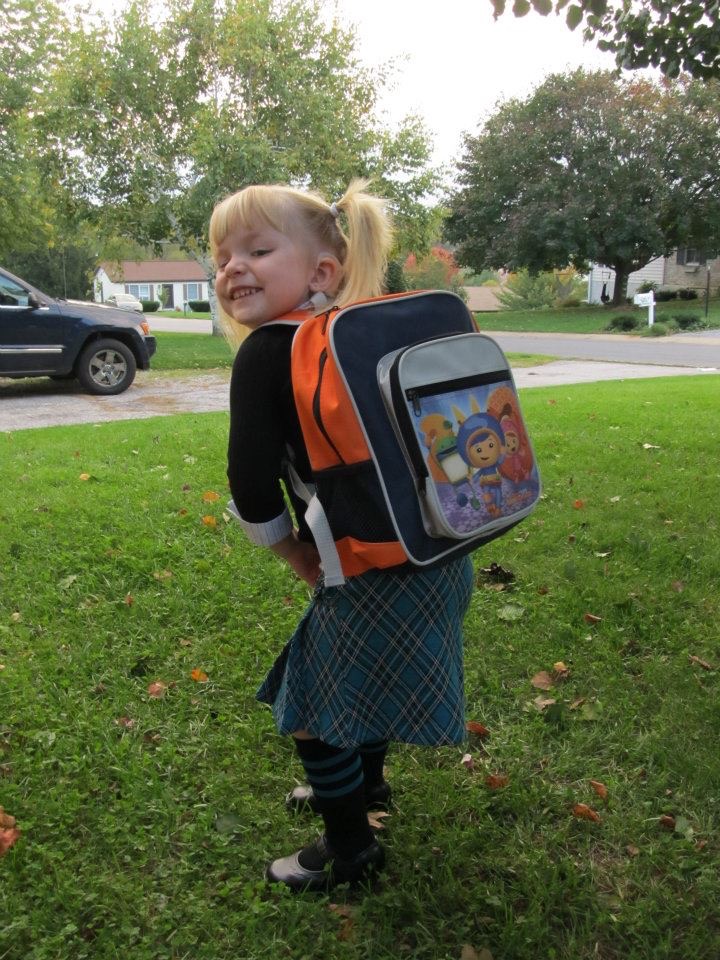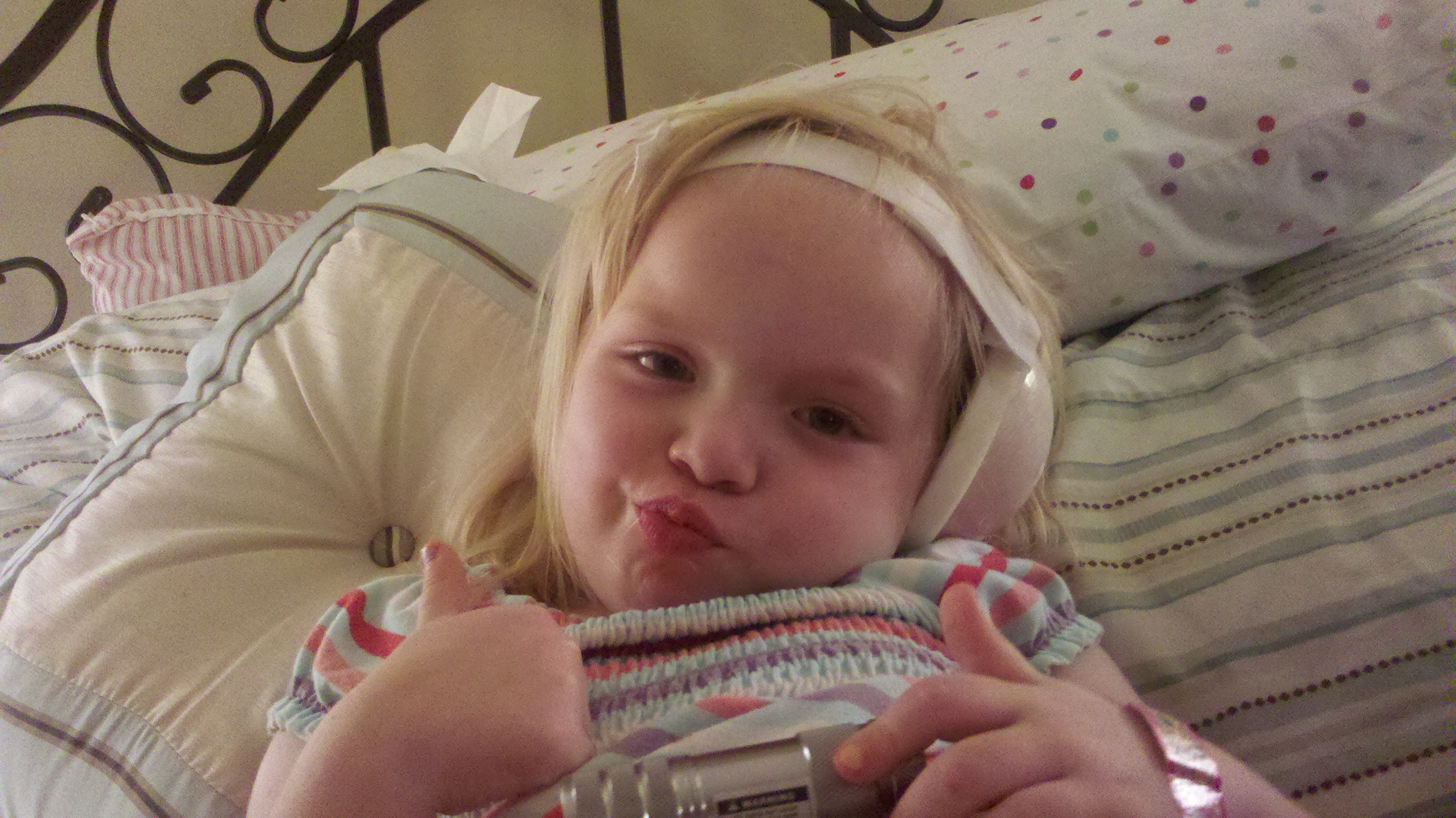Amy L. recounts her daughter’s harrowing journey with meningitis and hearing loss. After having a small window of time to decide whether to have her daughter implanted, Amy discusses their choice and how her daughter, Katie, is doing today.
“Friday, August 5, 2011 started off just like any other day. I did not think much of it when Katie told me she needed to stay home from preschool because she did not feel good. That was not an uncommon occurrence. Like most 4 year olds, she was ‘sick’ and ‘needed’ to stay home with Mommy at least twice a week. But, like every other time, she went to school with instructions that if she did not feel better after she had been there for a while, to call me and I would leave work and pick her up.
The school called me at around 11 a.m. to tell me she had gotten sick on the playground and I needed to get her. She did not have a fever and was acting normal otherwise. I picked her up and we went home to bake her grandmother a birthday cake. Katie was not quite herself but was not acting too out of character. She was excited about her grandmother’s birthday. That night she developed a high fever and got sick again. After alternating Tylenol and Motrin, the fever went away and she was back to her normal self. However, by Sunday morning, I could not keep her awake.
Getting the meningitis diagnosis
 I rushed her to an immediate care facility where they tested her for strep. The test came back negative and the doctor told me there was something wrong, they could not determine what it was but I needed to leave immediately and take her to the closest hospital. They called ahead so we were seen as soon as we got there.
I rushed her to an immediate care facility where they tested her for strep. The test came back negative and the doctor told me there was something wrong, they could not determine what it was but I needed to leave immediately and take her to the closest hospital. They called ahead so we were seen as soon as we got there.
The hospital took her for a chest x-ray to check for pneumonia. While moving her from one bed to another, the nurse noticed that Katie’s neck was stiff. She told me a stiff neck was a symptom of meningitis. They asked my permission to perform a spinal tap to test her for meningitis. I consented and they confirmed that she did have meningitis.
I was at a loss. I knew that meningitis was bad but did not know much about it. I asked the doctors and nurses what it could mean for her. They told me there are many strains of meningitis and it would depend upon the type she had. Tests had to be run before they could tell me what strain she had and the results would take days.
Because that hospital did not have a pediatric intensive care unit, Katie had to be transferred to another hospital. When we got to the next hospital, Katie was quarantined until they could determine what strain of the disease she had and if she was contagious. It was not until Tuesday when the doctor told me she was ‘out of the woods’ and would not die from the disease. There was still a likelihood of other side effects, the most common being deafness. I remember thinking to myself, ‘I will gladly take a deaf Katie over no Katie.’
Meningitis and hearing loss
 Katie was in the hospital for 11 days while her body fought off the bacterial pneumococcal meningitis. During her stay, we could notice a slight decline in her hearing. Nothing too drastic, but noticeable. Other than the slight hearing loss, there did not seem to be any other side effects from the meningitis. At the end of August, Katie had a follow up appointment with the neurologist to make sure the disease had not caused any issues with her brain or development.
Katie was in the hospital for 11 days while her body fought off the bacterial pneumococcal meningitis. During her stay, we could notice a slight decline in her hearing. Nothing too drastic, but noticeable. Other than the slight hearing loss, there did not seem to be any other side effects from the meningitis. At the end of August, Katie had a follow up appointment with the neurologist to make sure the disease had not caused any issues with her brain or development.
On the morning of the appointment, while we were getting ready to leave the house, she told me to stop talking funny because she could not understand me. I was not talking funny; her hearing had deteriorated so much that she could not understand what I was saying. The rest of the day was a whirlwind. After the neurologist appointment, we were seen on an emergency basis at an ear, nose and throat doctor (ENT) to check her hearing; she had profound hearing loss in both ears. That is when we learned about cochlear implants.
Learning about cochlear implants
 Up to that point, no one in the family knew what cochlear implants were. The doctor explained that, if she were eligible, Katie would benefit from cochlear implants and be able to hear again. One of the main concerns about getting her implanted was that meningitis causes bone growth inside the cochlea, where the electrodes need to be implanted. If we waited too long, the bone growth could make it impossible for her to be implanted and then she would never hear again. We had a short amount of time to do our research, and it was scary.
Up to that point, no one in the family knew what cochlear implants were. The doctor explained that, if she were eligible, Katie would benefit from cochlear implants and be able to hear again. One of the main concerns about getting her implanted was that meningitis causes bone growth inside the cochlea, where the electrodes need to be implanted. If we waited too long, the bone growth could make it impossible for her to be implanted and then she would never hear again. We had a short amount of time to do our research, and it was scary.
We were not sure how it would affect her life. After much consideration, second opinions and talking with other families who had similar experiences, her father and I decided to have her implanted. Her audiologist recommended the Cochlear™ Nucleus® 5 Sound Processor because it was the newest technology at the time.
In mid-September, she was implanted on her left side. Katie’s left ‘ear’ was activated in October and she took to it immediately. Because she had her speech before she lost her hearing, she did not need speech therapy. By the end of October, she was back in preschool with all her friends. By March of the following year, Katie was bilaterally implanted (implanted on both sides).
Upgrades and better hearing performance
 In the fall of 2017, her processors were upgraded to the Nucleus 7 Sound Processor. Katie says the sound with the new processors is clearer than before. Two of our favorite accessories are the Aqua+1 kit and the True Wireless™ Mini Microphone. The Aqua+ kit has made it so Katie can swim with her ‘ears’ on, which means she can hear us and lifeguards, when she is in the pool or the ocean. The Mini-Mic is especially helpful when she is playing sports. It was hard for her to hear her coach on the soccer field before, but now she can give the Mini-Mic to her coach and not miss a direction.
In the fall of 2017, her processors were upgraded to the Nucleus 7 Sound Processor. Katie says the sound with the new processors is clearer than before. Two of our favorite accessories are the Aqua+1 kit and the True Wireless™ Mini Microphone. The Aqua+ kit has made it so Katie can swim with her ‘ears’ on, which means she can hear us and lifeguards, when she is in the pool or the ocean. The Mini-Mic is especially helpful when she is playing sports. It was hard for her to hear her coach on the soccer field before, but now she can give the Mini-Mic to her coach and not miss a direction.
Having her implanted was the best decision we could have made for her. The entire experience has made her a very strong and independent girl. The implants do not hold her back and most people do not realize she is deaf. Katie is now 11 years old and is in all honors and advanced placement classes at her middle school.
She enjoys doing all things that normal-hearing children do: soccer, basketball, softball, downhill skiing, horseback riding, playing the cello and swimming. Reading is her favorite thing to do. She loves to educate people who ask about her ‘ears’ and explain how they work. When Katie grows up, she wants to be an audiologist so she can help people hear and teach them about all the benefits of her ‘ears’.”
Did your child lose their hearing from meningitis? Check out our resources and information on cochlear implants.
- The Nucleus 7 Sound Processor with Aqua+ and Aqua+ Coil is water resistant to level IP68 of the International Standard IEC60529 when you use a Cochlear Standard Rechargeable Battery Module or Cochlear Compact Rechargeable Battery Module. Refer to the relevant User Guide for more information.